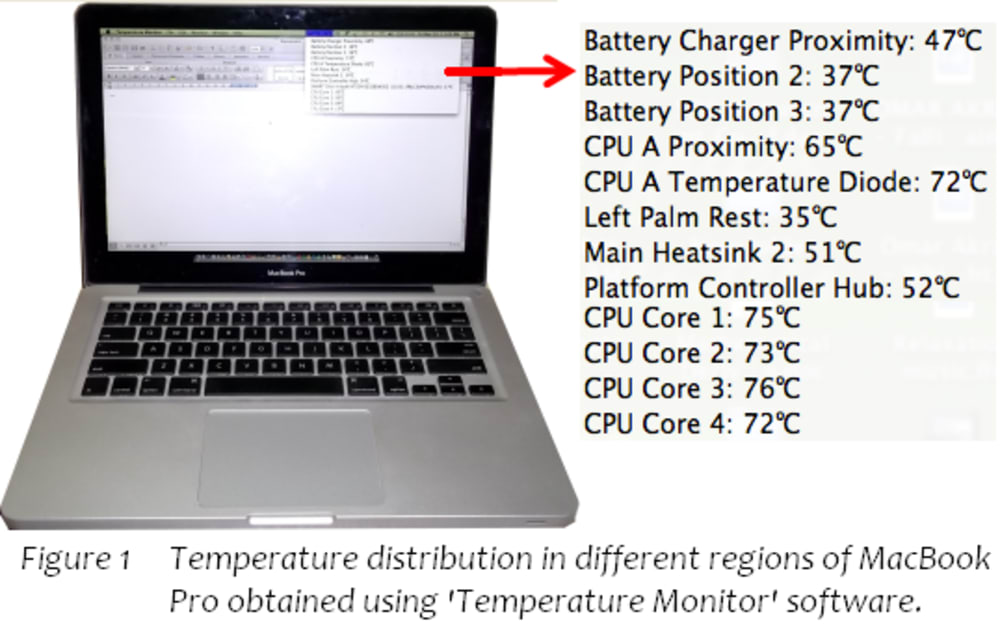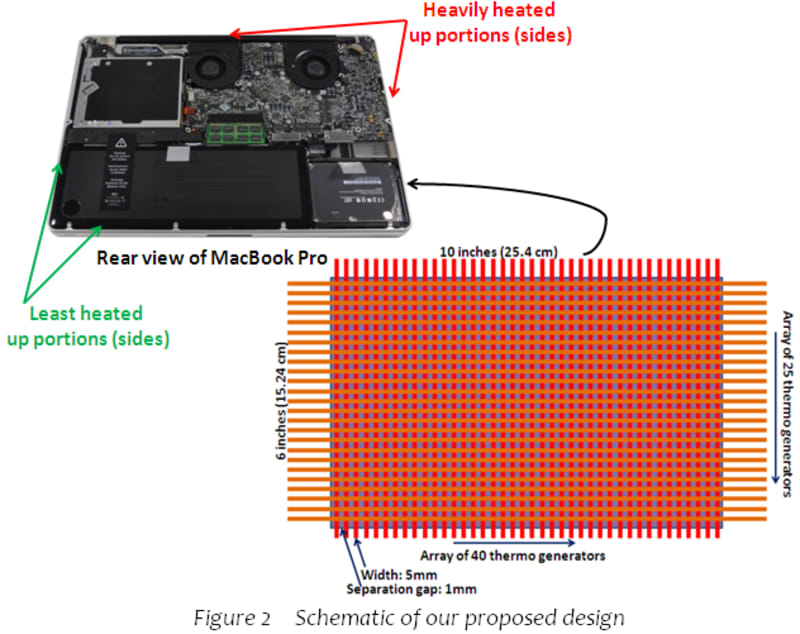
Background and scope of invention
This invention deals with improvement of battery backup of laptops by recycling the waste heat generated during the process. Laptop batteries used today have a limited backup time ranging from three to six hours. During long journeys, corporate meetings, and long power failures inconveniences are caused due to limited backup time of batteries.
Issues
During operation, overall laptop system generates tremendous amount of heat with peak temperature in vicinity of processor. Figure 1 demonstrates temperature in different sections of a MacBook Pro laptop and it can be inferred that a huge fraction of electrical energy supplied to the laptop is dissipated into heat energy. This inspired us to develop a novel system which could use this waste heat, convert it into electricity and recycle it to improve the battery backup.
Envisaged outcomes
•Enhanced backup time.
•Less discharge rate of battery:Increases longevity of battery.
•Battery lasts longer thus making the system more economical.
•Reduces pollution caused due to battery replacement, as batteries generate a large volume of solid wastes today which are chemically toxic.
Solution
The issue is solved here using thermoelectric effect, which is conversion of temperature gradient into electricity. Thin film thermoelectric generators are already available in market generating considerable power for per degree temperature gradient. For example the thermo-generator (TEG) array manufactured by Thermo Life Energy Corporation can generate 3 Volts, 10 micro-amperes at a temperature gradient of 5 Kelvin. Till now we could achieve 1.1 Volts, 22 micro-amperes for a temperature gradient of 5 Kelvin when a load of 100 ohm was connected to the TEG. The cost incurred in fabrication of such array does not exceed $5 each and in batch production the cost goes down to few cents. The image pertaining to the proposed set up is as shown in Figure 2.
Our achievements
To test the applicability of our proposal, a TEG array was placed inside the laptop during its run. It was observed that due to temperature gradient of more than 40 Kelvin during laptop operation, 122 micro-ampere hour could be harnessed at an average voltage of 4.7 Volts.
Our proposed design houses 975 such arrays as shown in Figure 2. It is possible to obtain (122 micro-ampere hour X 975 arrays) 119 mAh (milli-ampere hour) at 4.7 Volts.
Manufacturing and scope for realistic implementation
With rapid advances in micro-manufacturing it becomes very easy, reliable and cost effective to induce such products in the market. The idea is not yet implemented by any existing laptop companies. The system designed is cost effective. Further miniature size, light weight and higher energy production capability makes it a promising technology for future.
Proposed design specs of final product for MacBook Pro
Type: Single silicon wafer based (Monolithic).
Output voltage: 4.7 Volts.
Output Current: 119 mAh
Number of Thermoelectric arrays: 975.
Dimensions: 25.4 X 15.24 X 0.2 centimeters.
Estimated weight: 55 grams.
Estimated manufacturing cost: $10.
-
Awards
-
 2012 Top 100 Entries
2012 Top 100 Entries
Like this entry?
-
About the Entrant
- Name:Soumen Mandal
- Type of entry:teamTeam members:1. Shishir Kumar Singh- CMERI CSIR, India.
2. Sangeeta Mandal- Lovely Professional University, India.
3. Sandhya Jha- Tata Consultancy Services, India. - Software used for this entry:E-Draw, Adobe Photoshop
- Patent status:none













